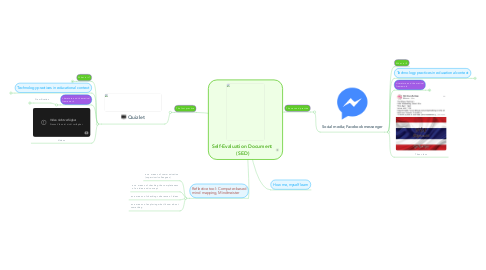
1. The first practice
1.1. Quizlet
1.1.1. What is it?
1.1.1.1. A free website providing learning tools for students. Allow users to customise the content.
1.1.1.1.1. Flashcard
1.1.1.1.2. Study mode
1.1.1.1.3. Game mode
1.1.2. Technology practices in educational context
1.1.2.1. How I use it?
1.1.2.1.1. To create teaching material; Thai vocabulary study set.
1.1.2.1.2. Teach in one-on-one Thai class, with 11 yrs student.
1.1.2.2. Why I use it?
1.1.2.2.1. To enhance student' engagement
1.1.2.2.2. To stimulate student' motivation
1.1.2.2.3. To understand student
1.1.3. Literature and theoretical framework
1.1.3.1. Gamification
1.1.3.1.1. Language in games
1.1.3.1.2. Challenge
1.1.3.1.3. Engage personal value
1.1.3.1.4. its core, gamification is about engaging people on an emotional level and motivating them to achieve their goals
1.1.4. Videos
2. Reflective tool : Computer-based mind mapping, Mindmeister
2.1. as a means of communication (supervisor/colleagues)
2.2. as a means of checking the completeness of an idea and concept
2.3. as a means of checking coherence of ideas
2.4. as a means of exploring what I know about something
3. The second practice
3.1. Social media; Facebook messenger
3.1.1. What is it?
3.1.2. Technology practices in educational context
3.1.2.1. How I use it?
3.1.2.1.1. To create a virtual communities of practice. (Thai learning Facebook chat group)
3.1.2.1.2. Use as a tool to arrange Thai class with linguistic society.
3.1.2.2. Why I use it?
3.1.2.2.1. To support my teaching and learning practice
3.1.2.2.2. To create communication channel among me and my students, accessible and fully engage.
3.1.3. Literature and theoretical framework
3.1.3.1. virtual communities of practice
3.1.3.2. Connectivism
3.1.3.2.1. the teacher(me) – learner (my students)– technology(Facebook) relationship
3.1.3.2.2. information landscape
3.1.3.2.3. learner generated content
3.1.3.2.4. peer- shared context
3.1.3.2.5. Learning = knowing content + interaction with world
3.1.3.3. social networking and socio-cultural
3.1.3.3.1. social network and community of practices
3.1.3.4. the zone of proximal Development
3.1.3.4.1. Quantum theory of trust
3.1.4. Thau class
